INDEX
- English
- 日本語

Red and orange autumn leaves scattered about a moss garden in Kyoto - English
- 日本語

Matsutani Shigeru, visiting professor at Kyoto Prefectural University
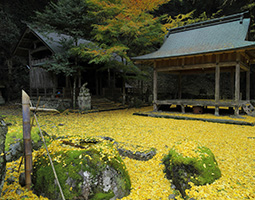
The yellow carpet laid by the gingkoes at Iwato Ochiba Shrine in Kyoto 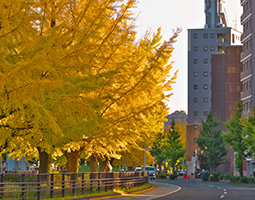
The bright yellow autumn colors of the gingko trees lining Horikawa-dori in Kyoto 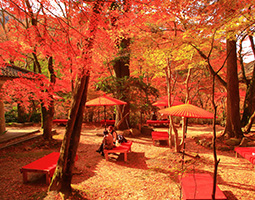
The many autumn colors of Zuiho-ji Park at Arima Onsen in Kobe, Hyogo Prefecture 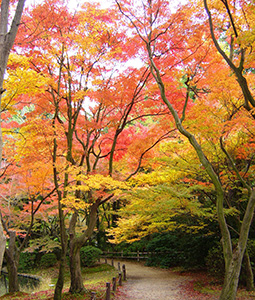
Fall foliage near the Nakaragi-no-Mori forest in the Kyoto Botanical Gardens 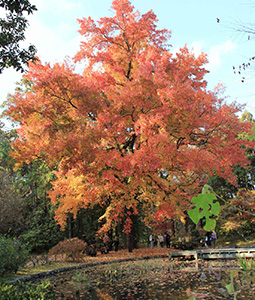
The autumn leaves of the Formosan gum tree in the Hydrangea Garden at the Kyoto Botanical Gardens
- PREVIOUS
- NEXT
September 2021
The Autumn Colors of Japan

Since ancient times, Japanese people have appreciated the changing colors of fall just as much as the cherry blossoms in spring. We spoke with Matsutani Shigeru, the honorary director of Kyoto Botanical Gardens and a visiting professor at Kyoto Prefectural University, about the highlights of autumn colors in Japan.

Colorful autumn leaves appear all across Japan in the autumn. Is there a particular reason for this?
Japan gets ample rainfall for trees to grow. Also, two-thirds of the country is covered in forests and there are a wide variety of tree species. Deciduous trees whose leaves change color in autumn are distributed across Japan, allowing one to see autumn colors in almost all regions of the country.
For many deciduous trees, the leaves begin to change color when days with a low of 6°C or 7°C continue. As the islands of Japan stretch from north to south, the leaves begin to change in the mountains of northern Hokkaido from the middle of September, and from there, the changing colors move south from the Tohoku region on down to the Kanto region, which is home to Tokyo. Kyoto, where I live, is somewhat to the west, and usually the best time to see autumn leaves is from the end of November until the beginning of December.
It is thought that the brightly-colored, beautiful fall leaves are due to changes in the amount of red, yellow, and other pigments in the leaves when natural conditions are met. These conditions include ample sun during the day, a great disparity in temperatures between night and day, a low of around 5°C for an extended period of time, and when trees get a suitable amount of water.

Please tell us about the charm of Japan’s autumn colors.
There are many varieties of deciduous trees in Japan, so one great attraction is that you can see a variety of fall colors here, including red, yellow, yellowish-brown, and orange. The species known as “Japanese maple” is the tree that symbolizes the autumn colors and has leaves that turn red. This maple grows naturally in many parts of Japan and is also planted in many parks, gardens, temples, and shrines. The gingko tree is best-known among trees in Japan that turn yellow. You frequently see this tree as a roadside tree in Japan. Several trees including the oak, beech, and Chinese cork oak that grow naturally in many Japanese forests have leaves that turn yellowish-brown.
Because not only these kinds of deciduous trees grow in the forests of Japan, but also evergreens, you can see greens among other colors during the autumn leaf season. You could say that the charm of Japanese fall colors is the beauty of this combination of various colors.

Why does Kyoto have such a large number of famous spots for viewing autumn leaves?
Kyoto City is in a basin surrounded by mountains, and so the difference in temperature between day and night is great. From around early November, there are some days where the temperature drops to around 6°C or 7°C. The Kamogawa river also flows through the city, so there is always a moderate amount of humidity. In this way, the city features the natural conditions mentioned before that are needed for the autumn colors to be beautiful. Moreover, there has been a culture of admiring the fall foliage in Kyoto since ancient times. During the Heian period (from the end of the 8th century until the end of the 12th century), when Kyoto was the capital of Japan, among the aristocracy appreciating fall leaves became an important event for enjoying the season, similar to cherry blossom viewing. Nobles would visit the mountains near Kyoto when the leaves changed colors and would compose waka* poetry about the beauty of the leaves. Eventually, in order to see and enjoy the fall colors up close, Japanese maple and other trees whose leaves change color in autumn were planted at the residences of the nobility. Kyoto is the main setting of The Tale of Genji, written by Murasaki Shikibu in the middle of the Heian period, and many depictions of the changing colors appear throughout the story.
Later, trees with leaves that changed color in autumn came to be planted in gardens and on the grounds of temples and shrines in Kyoto. There is an elegance to the autumn leaves of the Japanese gardens at temples and shrines with many hundred years of history. The contrast between the green of pine trees and moss and the red of Japanese maple trees in these gardens is an extraordinary sight.

Can you tell us about a spot for these fall leaves that made a lasting impression on you?
Iwato Ochiba Shrine, located in the mountains of northern Kyoto City, is a small shrine that few know about. An incredibly beautiful spectacle appears when the leaves of the several large gingko trees on the shrine grounds change into a bright yellow. When the leaves have finished changing, they fall to the ground, and it appears as if an actual yellow carpet has been laid down.
You can also enjoy various autumn colors in Kyoto at places other than shrines and temples. For example, gingko trees are planted along Horikawa-dori, a street that runs north–south through central Kyoto. The sight of rows of large yellow-hued gingko trees is truly impressive.
I also recommend the Karato valley, located in Miyama Town, Nantan City, about two hours north by car from the central part of Kyoto City. More than 90% of the nature-rich Miyama-cho area is covered in forests, and Karato valley is also surrounded by dense forests. When autumn comes, the steep valley is dyed red, yellow, orange, and a variety of other colors from the deciduous trees, in addition to the greens of the evergreens.
It’s not in Kyoto, but you can also see incredible fall colors at Zuiho-ji Park in the famous Arima Onsen hot spring resort in Hyogo Prefecture close to Kyoto. The vibrant red of the Japanese enkianthus is particularly impressive.

Please tell us about the fall colors at the Kyoto Botanical Gardens where you served as chairman from 2006 to 2010.
The Kyoto Botanical Gardens holds about 12,000 varieties of plants from around the world on 24 hectares of land. About 55,000 trees are cultivated within the gardens, and of those, about 2,000 have leaves that change colors in the fall. For example, Japanese maple and other trees change colors in autumn in the Nakaragi-no-Mori forest of the gardens. The leaves of the large Formosan gum**i tree in the Hydrangea Garden, more than a century old, change from green to yellow, orange, and then red.
Deciduous trees won’t show beautiful colors if they don’t get enough water before changing. This is why having employees water the trees is extremely important. If there isn’t enough water, the ends of the leaves become slightly round. To keep from overlooking this subtle change, employees check the trees one by one each day and sprinkle water where needed.

Please tell us how you recommend enjoying the fall colors.
Tree leaves do not suddenly change from green to red or yellow. The leaves begin to change color from the sunny upper leaves, and this gradually spreads to the entire tree. It’s great fun to observe this transformation.
While it’s fine to look at the changing trees from afar, I also recommend viewing them up close. You can see the difference in the colors of each individual leaf. Some leaves may have changed color only on the spots that get direct sunlight, with the parts in the shadow still green. You may also discover new beauty by standing directly below the foliage and looking up at the leaves from behind against the sun.
* A classic Japanese poetic form consisting of 31 syllables divided into five parts with five, seven, five, seven and seven (5-7-5-7-7) syllables in each. Nowadays, it is also called “tanka.”
** The Formosan gum is a tree in the Altingiaceae family, with three-lobed leaves. This tree is often planted in parks and along roads in Japan.
- PREVIOUS
- NEXT

